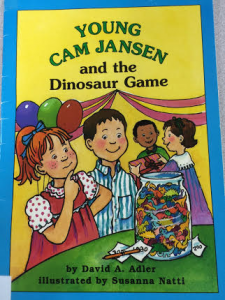

Author: David A. Adler
Illustrator: Susanna Natti
Publishing Information: Scholastic, 1996
Number of Pages: 32
Genre: Mystery
Analysis:
The story of Young Cam Jansen and the Dinosaur Game follows Cam and her friend David as they attend a birthday party that features a guessing game. When one of the partygoers guesses the exact number of little toy dinosaurs in the glass jar, Cam is suspicious that there was cheating involved and decides to use her detective skills to investigate. She comes to find that the boy who won the game placed a second bet after the number had already been revealed, and the mystery is solved.
The illustrations are done in fairly basic colors (blue, red, yellow, green) and are featured in rectangular frames. This gives readers a more limited glimpse at the scenarios unfolding, which is similar to that of the limited information Cam begins her investigation with. Furthermore, the rectangular frames indicated less security than that of round frames, which is fitting for the plot as there is a mystery that has presented itself and has not yet been solved. These illustrations are additive to the text, as some reveal more information and visuals that the text could not have provided alone. For example, one of the illustrations features the slip of paper that had the exact number of dinosaurs on it where one can see smudges of chocolate on the paper. This is important because the guessing game required the children at the party to place their guess before cake was served, and clearly this guess was made afterwards.
This story is broken down into five short chapters, which introduces younger readers to the breakdown of traditional chapter books. Furthermore, the story teaches children a way to engage in more critical thinking as they follow along with Cam’s thought processes as she is solving the mystery. At the end of the story, the person who had the next closest guess is awarded the jar of dinosaurs and opts to share them with everyone else at the party, including the boy who cheated to win the game. This teaches children the value of sharing, as well as not holding a grudge against someone who did not act fairly toward others.
